Can U.S. $17 Trillion In Debt Survive Higher Interest Rates?
Interest-Rates / US Debt May 14, 2014 - 06:04 PM GMTBy: Dan_Amerman
 The United States federal government currently has about $17.5 trillion in debt outstanding. What this means is that if the interest rate on that debt were to rise by even 1%, the annual federal deficit rises by $175 billion. A 2% increase in interest rate levels would increase the federal deficit by $350 billion, and if rates were 5% higher, the annual federal deficit rises by $875 billion.
The United States federal government currently has about $17.5 trillion in debt outstanding. What this means is that if the interest rate on that debt were to rise by even 1%, the annual federal deficit rises by $175 billion. A 2% increase in interest rate levels would increase the federal deficit by $350 billion, and if rates were 5% higher, the annual federal deficit rises by $875 billion.
Clearly, the federal government cannot afford substantially higher interest rates.
At the very same time, because of the current extremely low interest rate environment, tens of millions of retirees and long term investors have seen their returns slashed, with potential reductions in their standard of living as well.
Could it be there is a fundamental clash between the financial interests of the federal government and the financial well-being of long term retirement investors?
A Mysterious Reduction In Interest Payments
The graph below shows the amount of federal debt outstanding over the last 40 years. As can easily be seen, the federal debt exploded upwards with the financial crisis of 2008, and began its meteoric rise to $17.5 trillion dollars outstanding.
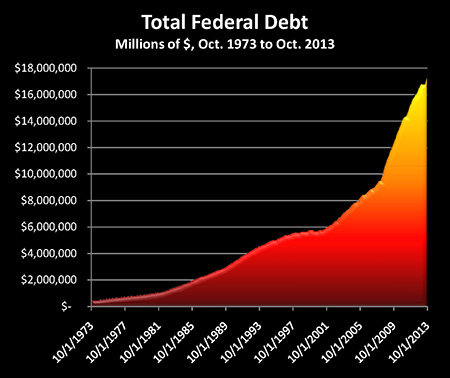
(source of data, first 4 graphs: Federal Reserve Bank of St. Louis)
Now ordinarily if we think about having our debts balloon out of control, we would expect to be making much higher interest payments.
All else being equal, if our debt doubles or triples then our interest payments should double or triple.
However, as can be seen in the graph below, this hasn't happened for the US government.
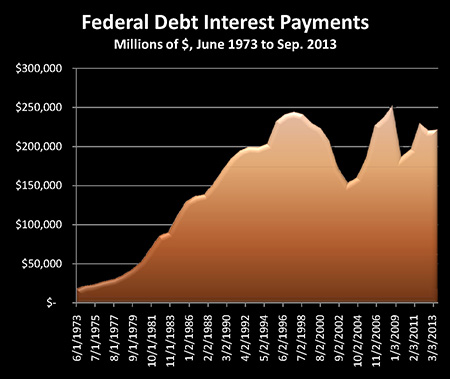
Indeed, interest payments by the federal government have either been falling or level ever since the financial crisis began.
How can this be?
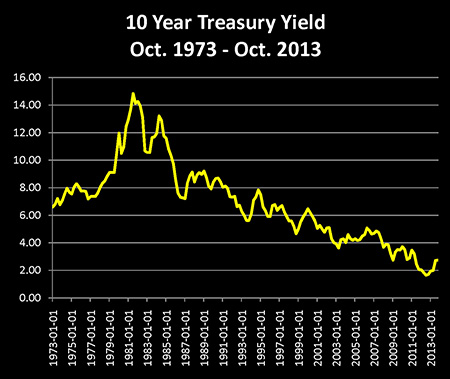
The answer, as plainly seen in the graph, is that interest rates have in recent years plunged to their lowest levels in the last 40 years.
At the very same time, savers and investors have of course also been experiencing these very low interest rates.
The Real Reason For Quantitative Easing
Now if the federal government were an individual, one might think that this was extraordinarily good luck. To have interest rates plunging even as the amount of debt outstanding was soaring upwards.
And generally speaking, this is where a lot of confusion can occur when trying to understand the debt and the deficit, because indebted national governments which can borrow in their own currencies are nothing whatsoever like individuals or corporations being in debt.
In the case of the United states, interest rates have been controlled for some years now through the Federal Reserve and its program of quantitative easing.
As illustrated in the graph below, at the very same time that the federal deficit has been soaring, the Federal Reserve has been creating quite literally trillions of dollars out of the nothingness and using this newly created money to purchase United States debt – not directly from the US government, but through the markets.
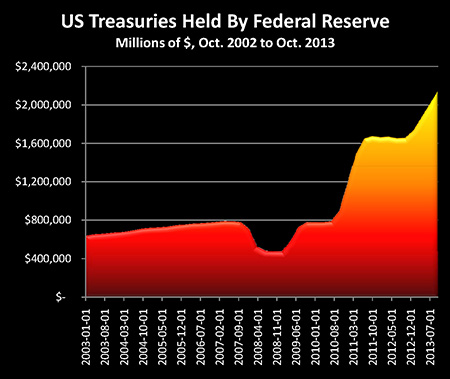
In doing so, the Fed has taken control of interest rates in the short term, medium term and long term in the United States.
There is nothing fortuitous or lucky about the low interest rates, but rather the government is dealing with a huge problem that it has with a very high debt level through quite deliberately taking control of interest rates and keeping them very low.
As explained more in depth here, the true purpose behind quantitative easing the entire time has been to reduce interest rates for the United States government and for mortgage borrowers.
The Impact On Savers & Investors
So it is the deliberate and massive market interventions by the Federal Reserve which slash the interest costs for a government that is $17.5 trillion in debt – even while it simultaneously has reduced interest rates to some of the lowest levels that savers and investors in the United States have ever seen.
What is the impact for someone who is pursuing a long term investment program, perhaps to fund a desired retirement lifestyle?
As can be seen in the graph below, a saver who invests at a 7% rate for 30 years can expect to turn a $10,000 initial investment into a $76,123 investment, meaning their total earnings were $66,123. This is the math that drives conventional long-term investment models – each dollar invested creates another six dollars and more, thus savers who practice long-term discipline are highly rewarded over time.
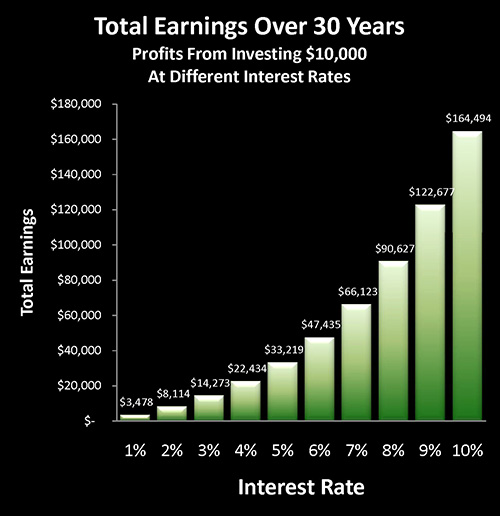
As shown, if we drop that interest rate to 1% – then the profits earned over thirty years plummet from $66,123 to $3,478, which is a reduction of 95%.
If interest rates turn out to be 2% on average, a saver would fare better with earnings of $8,114, but that is still a reduction of 88%.
On the other hand, if the saver were able to get a 10% rate of return, then their earnings would soar to $164,494, with that 3% increase in interest rates leading to a near tripling of investment returns.
The "Miracle" Of Compound Interest
Most of financial planning is arguably based on what many people consider to be the "miracle" of compound interest. The basic principle is that if we engage in a disciplined process of saving and investing money over a period of decades, then our wealth will compound as our money works for us, building a surprisingly large amount of savings over the years.
This principle applies whether we're talking about actual interest payments or assumed stock returns, and it is exactly why the advice is so widespread to begin saving for retirement in our 20s and 30s. For the longer the time period, the greater the compounding of returns and thus the more our money works for us, rather than us working for our money.
However there's another factor that can be even more important than the length of time invested, and that is the rate at which money is invested.
The interest rate or rate of return is what drives the compounding and creation of wealth, and when that drops too low – the fuel gets cut off, so to speak.
So the paltry 1% rates that many savings and retirement accounts are earning right now translate to losing 95% of anticipated earnings relative to 7%. Which could translate directly to a radically reduced retirement standard of living.
The bottom line is that for people to get the returns that they've been told they can expect with long-term savings – and to enjoy the retirement lifestyles that go with it – they need higher rates of interest than are currently available.
The Federal Government's Compound Interest Problem
While little remarked upon or understood, the United States government has a compound interest problem of its own when it comes to the debt and the deficit.
That is, tax revenues are not sufficient for the federal government to make either principal or interest payments on the federal debt.
So each time a principal payment is due – the federal government issues a new debt to get the money to pay off the old debt.
And each time an interest payment is due, the federal government issues new debt to make that interest payment. Indeed, borrowing the money to make interest payments is the source of over half of the annual federal deficit.
What this means is that the federal government has a compound interest problem, as shown in the graph below. It's not just that the level of interest rates goes up, but the amount of borrowing that must be entered into to pay those interest payments rises sharply as well.
The exact same rising interest rates that would provide what savers need – which is the the rapid compounding of investment interest – would simultaneously set off the extraordinary danger of a rapid compounding of debt interest for the federal government.
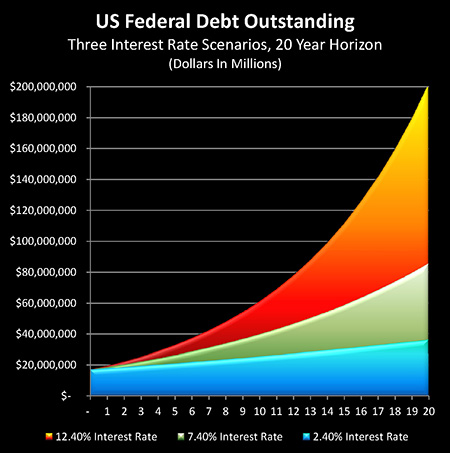
As shown in the graph, and explored in further detail here, a 5% increase in interest payments for the federal government would cause the level of federal debt to rise to $85 trillion over the next 20 years because of the compounding of interest, and a 10% increase in interest rates would cause the federal debt to climb to over $200 trillion.
Impact On Retirement Standard Of Living
The 2nd half of this article goes deeper into the direct and powerful conflict between the government and investors when it comes to interest rates. The effects of lower interest rates upon the amount of money that can be drawn down each year after retirement is analyzed, and how this creates a potential 30%-50% reduction in retirement standards of living as a direct result of the government's high debt levels, which is in addition to –and entirely separate from – the reduced wealth compounding explored in the first half of the article above.
Daniel R. Amerman, CFA
Website: http://danielamerman.com/
E-mail: mail@the-great-retirement-experiment.com
Daniel R. Amerman, Chartered Financial Analyst with MBA and BSBA degrees in finance, is a former investment banker who developed sophisticated new financial products for institutional investors (in the 1980s), and was the author of McGraw-Hill's lead reference book on mortgage derivatives in the mid-1990s. An outspoken critic of the conventional wisdom about long-term investing and retirement planning, Mr. Amerman has spent more than a decade creating a radically different set of individual investor solutions designed to prosper in an environment of economic turmoil, broken government promises, repressive government taxation and collapsing conventional retirement portfolios
© 2014 Copyright Dan Amerman - All Rights Reserved
Disclaimer: This article contains the ideas and opinions of the author. It is a conceptual exploration of financial and general economic principles. As with any financial discussion of the future, there cannot be any absolute certainty. What this article does not contain is specific investment, legal, tax or any other form of professional advice. If specific advice is needed, it should be sought from an appropriate professional. Any liability, responsibility or warranty for the results of the application of principles contained in the article, website, readings, videos, DVDs, books and related materials, either directly or indirectly, are expressly disclaimed by the author.
© 2005-2022 http://www.MarketOracle.co.uk - The Market Oracle is a FREE Daily Financial Markets Analysis & Forecasting online publication.



